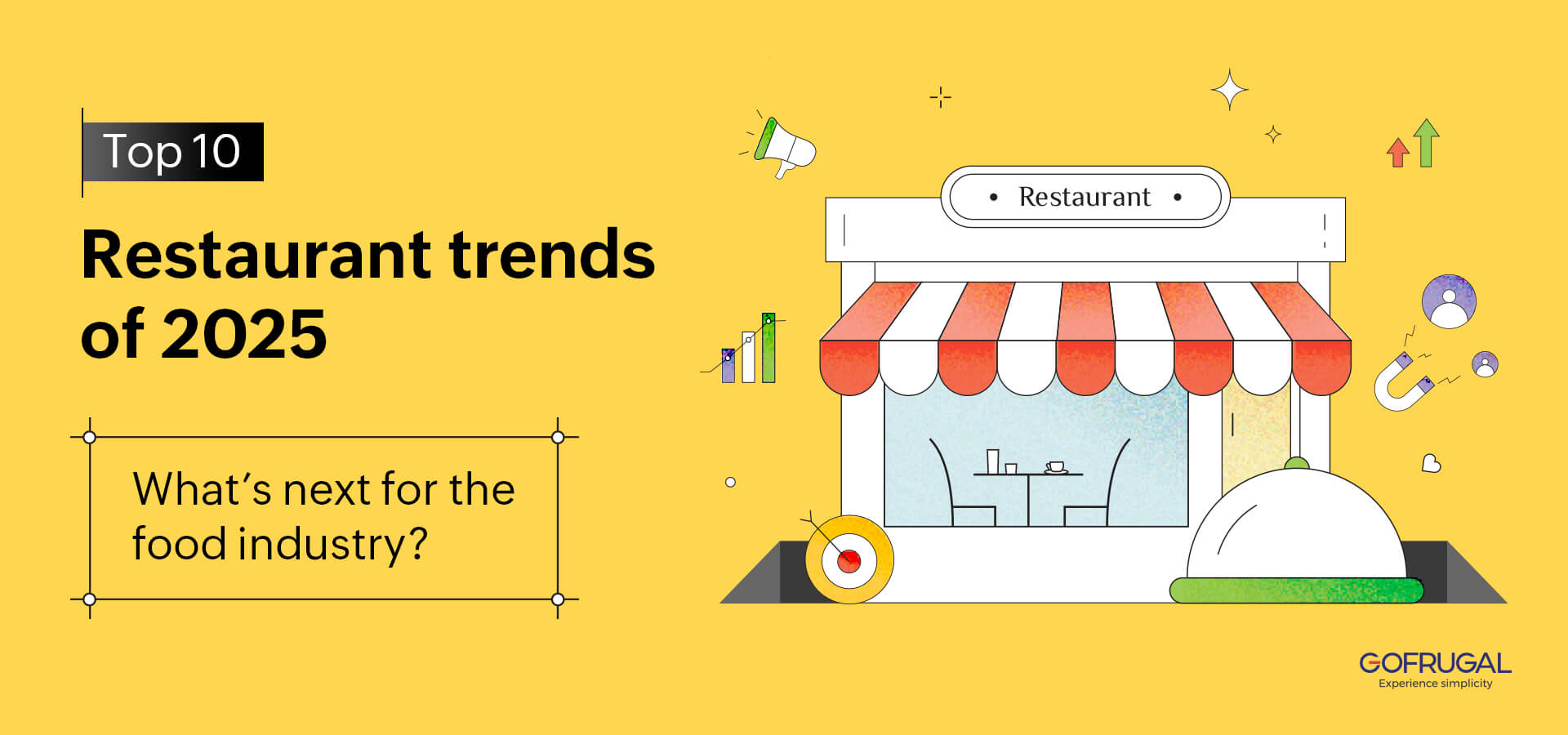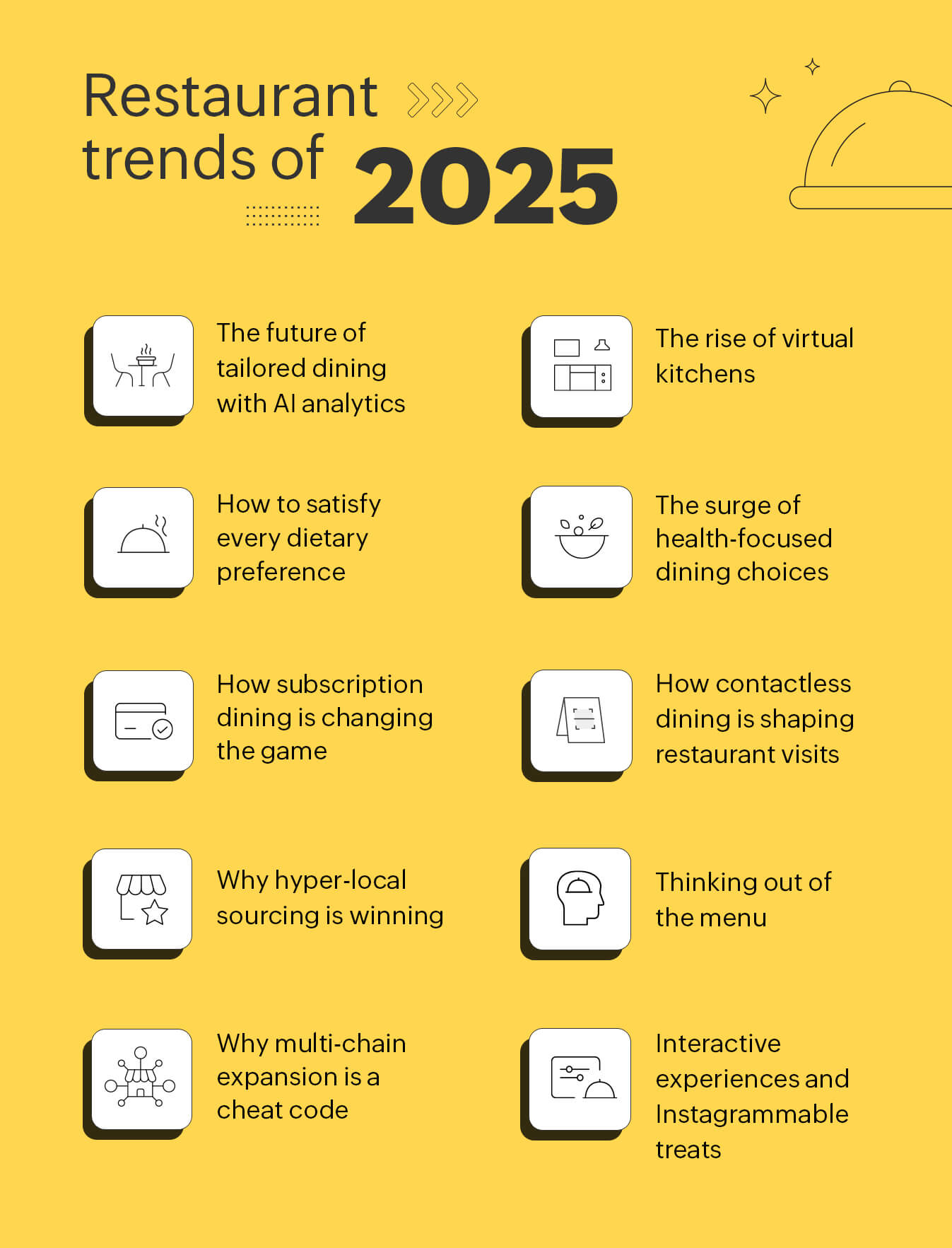 The restaurant industry has always been a reflection of evolving times—shifting tastes, new innovations, and changes in customer expectations. What was once a luxury has now become a necessity, and what was once a trend becomes the norm. From how food is prepared to how it’s served, every year brings fresh innovations that redefine dining. As we step into 2025, the restaurant landscape is once again undergoing a transformation. What’s next on the menu? From AI-powered analytics to health-conscious dining, take a look at the top trends shaping the future of the restaurant industry.
The restaurant industry has always been a reflection of evolving times—shifting tastes, new innovations, and changes in customer expectations. What was once a luxury has now become a necessity, and what was once a trend becomes the norm. From how food is prepared to how it’s served, every year brings fresh innovations that redefine dining. As we step into 2025, the restaurant landscape is once again undergoing a transformation. What’s next on the menu? From AI-powered analytics to health-conscious dining, take a look at the top trends shaping the future of the restaurant industry.
Table of content:
- The future of tailored dining with AI analytics
- The rise of virtual kitchens
- How to satisfy every dietary preference
- The surge of health-focused dining choices
- How subscription dining is changing the game
- How contactless dining is shaping restaurant visits
- Why hyper-local sourcing is winning
- Thinking out of the menu
- Why multi-chain expansion is a cheat code
- Interactive experiences & Instagrammable treats
The future of tailored dining with AI analytics
In today's world, AI does more than answer aptitude questions and solve complex problems. AI is revolutionizing industries, and the restaurant business is no exception. Enterprises have already started using AI integrations in automating repetitive tasks and improving efficiency. As a new restaurant industry trend, AI is now used for its ability to understand and learn customer behavior and preferences, helping restaurants improve customer experiences through hyper-personalization. By analyzing customer behavior, past orders, and dining preferences, AI-powered analytics can suggest specially curated menu recommendations, enhancing guest satisfaction and increasing customer retention.
AI analytics not only helps manage a guest's dining experience; it plays a crucial role in kitchen management by foreseeing and forecasting the demand of individual menu items by analyzing historical production and sales data so restaurants can plan their inventory and production accordingly, minimizing waste and maximizing profits.
The rise of virtual kitchens
Cloud kitchens, also known as virtual kitchens, are food establishments with only a working kitchen and no dining setup. These kitchens focus on preparing food for delivery or takeaway and are becoming the go-to business option for new food entrepreneurs planning to start a food business but with less capital cost and operating cost.
While cloud kitchens follow the same operational processes as traditional restaurants—handling procurement, inventory, and production—the key difference lies in order collection and fulfillment. Orders are received via food aggregators like Swiggy and Zomato, dedicated online ordering apps, or direct phone calls. With increasing consumer demand for home-delivered food, virtual kitchens provide a scalable, cost-efficient solution for restaurant businesses looking to expand their reach.
How to satisfy every dietary preference
One of the smartest leaps a restaurateur can make today is to adjust to varying dietary needs. As the number of people adopting vegan, plant-based, Keto, and other lifestyles continues to grow, restaurants have a tremendous opportunity to add personalization to the dinner experience.
Restaurants are able to offer dairy products, plant proteins, and gluten-free foods in response to customer's dietary needs. Providing menu items with proper labels using a barcoding software also brings transparency, and customers can make appropriate choices accordingly.
The surge of health-focused dining choices
Thanks to advisory campaigns and awareness, eating healthier while out has taken off, with more diners considering their nutrition and well-being. Whereas the last decade was all about indulgence, today’s diners are seeking meals that align with their health goals.
Restaurants hoping to cash in on this trend can create dedicated health-focused menu sections featuring low-calorie, gut-friendly, and organic dishes. Other benefits of showing nutritional values on the menu include trust and transparency with the customers since visibility empowers them to make better choices. Additionally, health-focused restaurants are an exciting opportunity for newcomers in the culinary world.

How subscription dining is changing the game
What if we could subscribe to meals like we subscribe to TV channels? This is not a new trend; this concept dates back to Mumbai’s dabbawalas in the 1930s who delivered home-cooked meals to office-goers. Now, modern subscription dining has evolved with technology.
Meal subscriptions provide consistency and quality, and—importantly for working professionals and students—saves time. Automated order management, digital payment processing, and customizable meal preferences allow restaurants to capitalize on a recurring revenue model. With modern technology to manage the subscription and handle the customer preferences, food businesses can definitely adapt to this technology.
How contactless dining is shaping restaurant visits
Covid 19 brought a lot of changes in almost all industries. In the food industry, where hygiene and safety is a top concern, contactless dining came about. This is managed by a contactless dining software where restaurants place their digital menu in the form of a QR code on each table, and guests can simply scan the QR code via their mobile app and place their orders, minimizing physical touchpoints while enhancing convenience.
This order will be reflected in the kitchen like any other order, and the kitchen processes remain the same. Whether it’s a fine-dining restaurant, a quick-service outlet, or even a food truck, contactless ordering has become a must-have for modern restaurant businesses. Simply create a digital menu and get started with a contactless ordering system for restaurants.
Why hyper-local sourcing is winning
Becoming popular now, consumers are opting for fresh, seasonal, locally-sourced ingredients to enjoy and experience local seasonal cuisines. Concepts like farm-to-table have begun to spread, with the aim to benefit local farmers, mitigate carbon footprints, and improve food quality.
Hyper-local sourcing gives customers a sense of connection to their meals, and helps them enjoy seasonal and regional delicacies. From a business point of view, local sourcing helps foster relationships with nearby food suppliers, ensures fresher produce, and helps create unique, location-based menu offerings.
Thinking outside of the menu
With more than 332,000 established restaurants in India—and a few thousand more opening every year—standing out means being creative. While excellent service and great food are essential, restaurants need to go beyond the bare minimum and think about more than the menu to create exceptional customer experiences.
Some innovative approaches include:
- Fusion cuisine - A cuisine combining elements of different culinary traditions.
- Health-focused menus - Featuring alternative proteins, fermented foods, and functional drinks.
- Themed dining - Creating pop-up restaurants with unique themes, chef’s table experiences, or interactive cooking.
By thinking beyond the traditional menu, restaurants can build a loyal customer base that returns not just for food, but for the experience.
Why multi-chain expansion is a cheat code
For any single-outlet restaurant that has been successful, the logical next step to improve their profitability and expand their reach is to transition into a chain business. Whether through company-owned branches or franchising, there are various ways to flourish and transport the restaurant trademark across territories.
While both of the above have their own merits and demerits, one thing common in all of them is increase in business and revenue. With dedicated restaurant franchise and restaurant chain management software, take care of your chain of restaurants or franchise your restaurant with centralized control and manage all of its operations while providing them the freedom to execute in areas you need. When done carefully, you can turn your brand into the next big franchise business.
Interactive experiences and Instagrammable treats
According to a study by TDn2K, reported on by White Hutchinson, ambiance and positive service have consistently been the strongest differentiating factors for top-performing restaurant brands. There are brands who spend a hefty amount of money on marketing and advertisement, and there are a few more smart brands who use their own customers as brand advocates.
In today's dining world, people not only enjoy the food and the experience they get, but they also share them via social media and public platforms, which drive organic marketing, turning customers into brand ambassadors. Create an interactive and pleasant experience for guests and curate the menu to cover all types of the audience for the restaurant brand. This includes ambiance, employee behaviors, and even the way the chef plates the dish!
The road to profitability
The restaurant business is always evolving. What begins as an experiment today can end up becoming the norm in the future. As we've seen, 2025 is expected to bring about innovations that go beyond food, changing the way restaurants function, interact with patrons, and produce unique dining experiences. These trends—which range from hyper-local sourcing and immersive dining to AI-driven personalization—all emphasize how important flexibility is.
To stay ahead, restaurant operators and owners must embrace change, whether it is through improved menus, smarter technology, or rethought service practices. Serving delicious cuisine is only one aspect of the future of dining; another is creating experiences that appeal to the new generation of customers. So, which trend will your restaurant adopt next?
